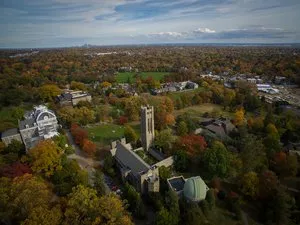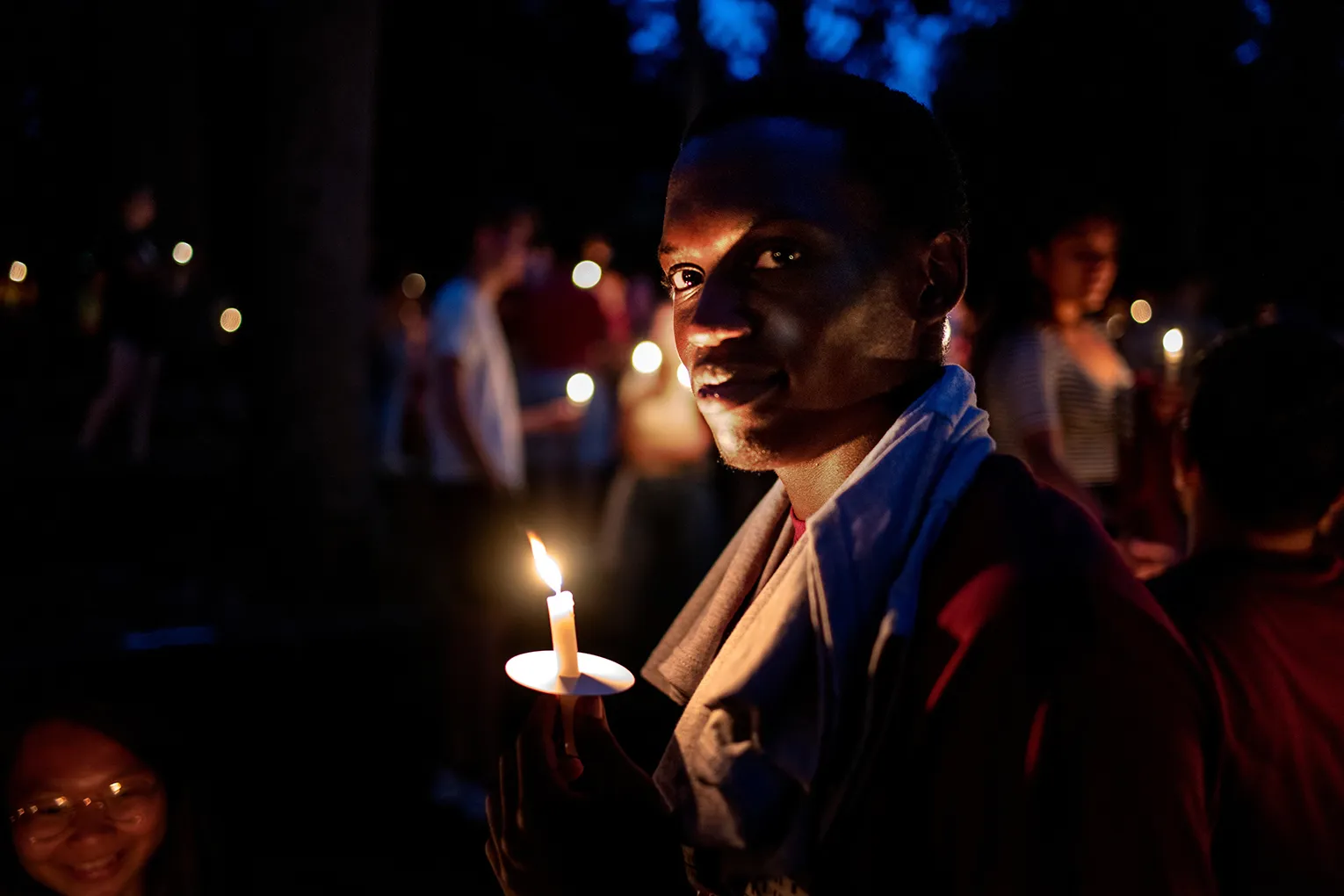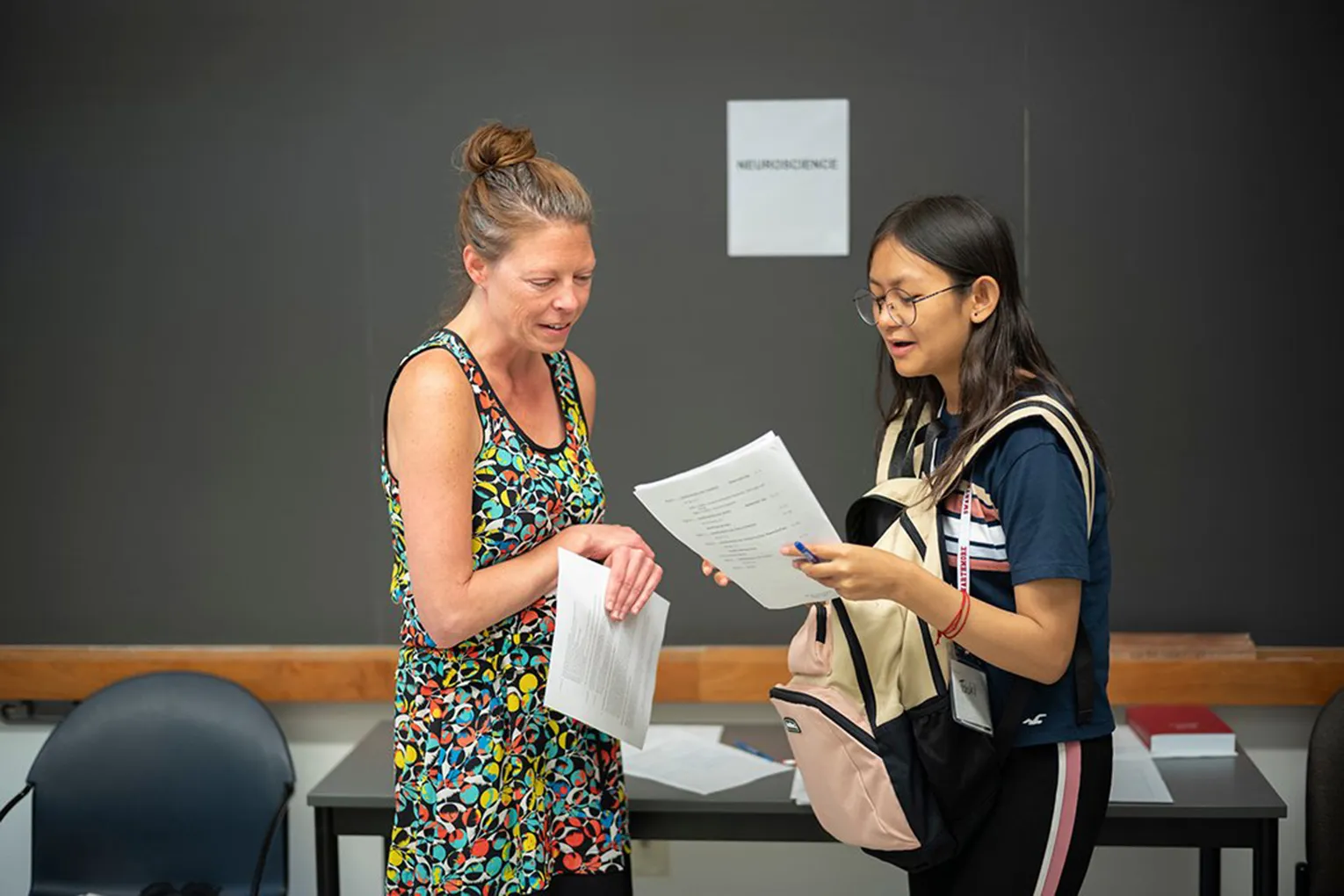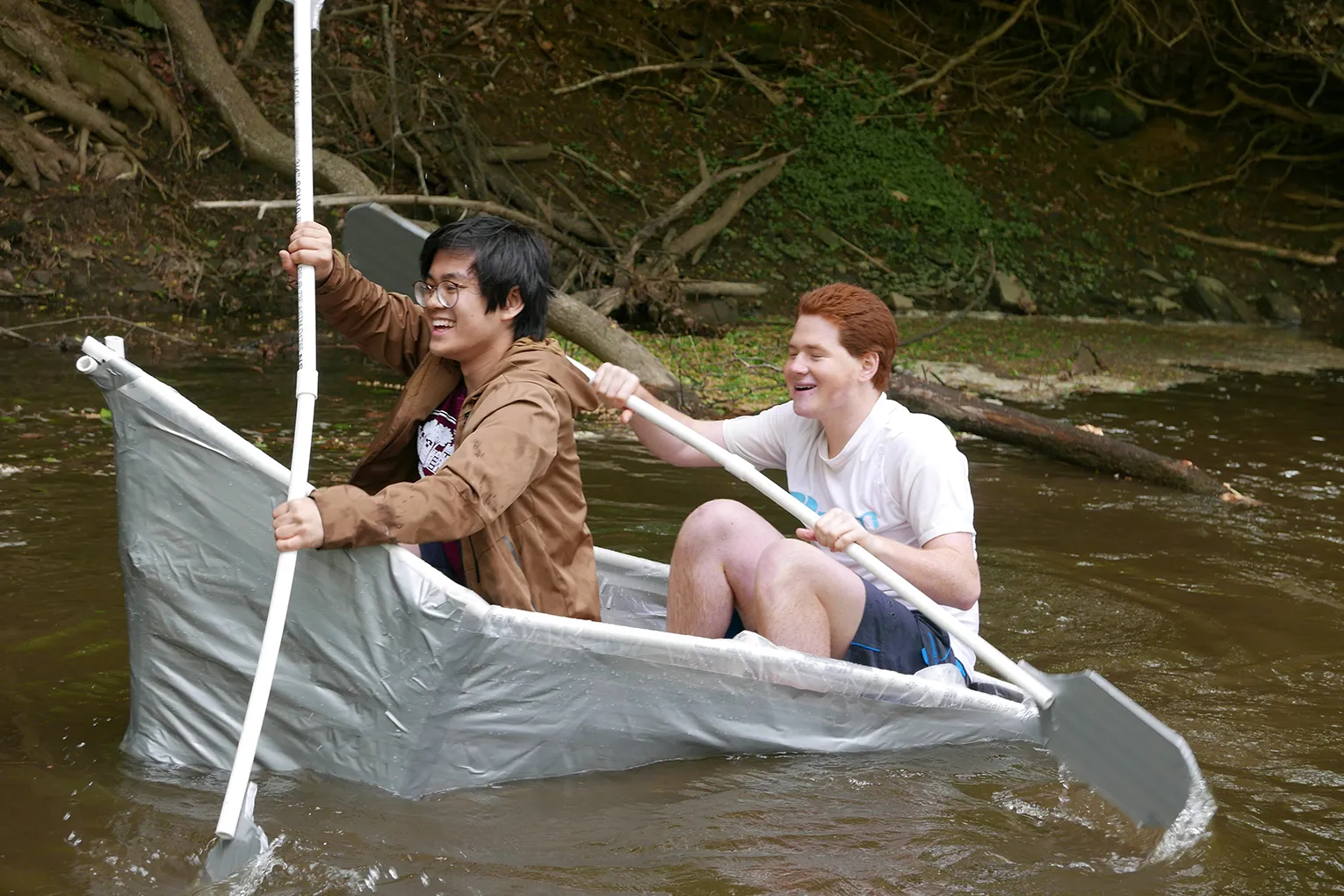Pedagogy of Play
The Libraries are bringing innovative technologies to the entire campus
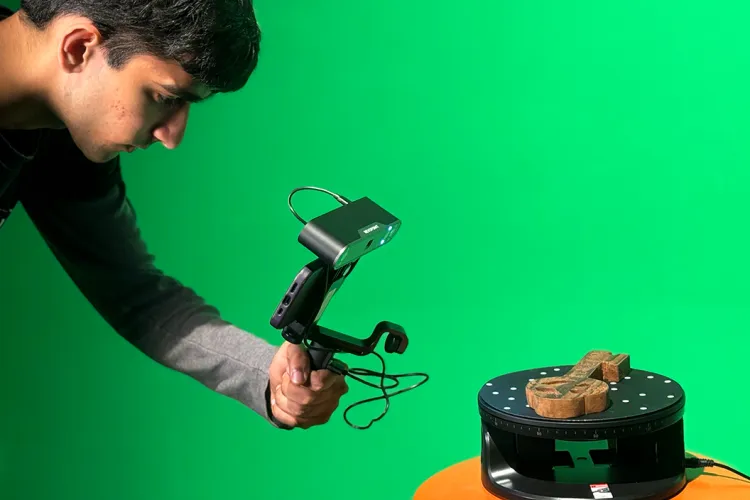
Student workers like Ahmad Fayyaz ’27 (above) helped 3D scan items in the Peace Collection so that they could be viewed from all sides digitally without being handled physically.
Did you know there are 15 virtual reality headsets available for students, faculty, and staff to use in McCabe Library? Since 2023, Head of Digital Scholarship Strategies and Visiting Associate Professor of English Amanda Licastro has been bringing virtual and augmented reality to Swarthmore classrooms and beyond.
“In our first year, we had VR integrated into 20 courses on campus,” she says, “and at least a dozen co-curricular events on campus, partnering with everyone from the Arboretum to Career Services to Accessibility.”
The uses for VR across campus are many, from recreation and wellness, to enriching the classroom experience, to bringing the Libraries’ archives to life.
Health & Wellness
“Our initial engagement was through the Trail to Wellness,” says Licastro. “Before finals, every semester, Student Health & Wellness creates multiple stations that students can walk through to take what I call a ‘brain break’ in the midst of finals stress, before they actually begin. There's a massage chair, there's arts and crafts activities, and we have the VR headsets for meditation apps.” At Trail to Wellness, there are three different VR meditation apps available to students.
“When you put on the headset, you cannot see anything else around you. You cannot use your phone, you cannot multitask, because it's stuck to your head,” says Licastro. “VR helps with a lot of invisible disabilities, things like ADHD, because of that ability for sensory deprivation.”
As a partnership between Athletics and the Libraries has shown, wellness can also be fun. On Friday, October 4, the two departments co-hosted a Beat Saber battle.
“Beat Saber is super fun. Imagine if Guitar Hero and Dance Dance Revolution merged. You have lightsabers in both of your hands, and blocks fly at you, and you have to hit them to the beat of the music,” says Licastro. “Thanks to Athletics, we had brackets, just like March Madness. We had an advanced bracket and a beginner's bracket, and we had prizes for the winners.”
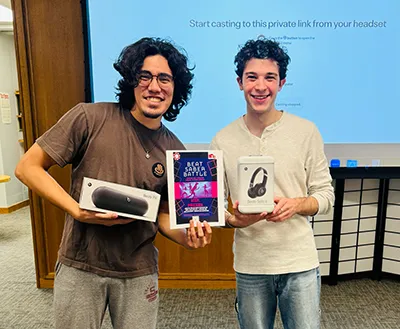
In The Classroom
Assistant Professor of Music Tracey Stewart designed her class More Than A Drumline to be experiential. The class explores the legacies and traditions of historically Black colleges and universities [HBCUs] with a focus on music, and marching bands in particular. She knew from the start that she wanted to bring students to games to witness and cheer on HBCU marching bands. But now, through VR, students are able to be not just in the stands, but in the band.
“Some people have been making 360 videos from the perspective of band members,” says Stewart. “We went to Amanda, and she found some videos for us on YouTube. Wearing the VR headset allowed students, and me, to be in the center of activity.
It’s as if I was in the middle of the trumpet section as they are warming up and getting ready for this performance,” adds Stewart. “Being able to look someone in the face, see details of them, details of their instrument, what they’re saying… being kind of close without being right there. It was pretty cool.”
John Word, Language Center manager in ITS, is supporting Stewart in creating her own 360 videos of Howard University’s ‘Showtime’ alumni band, of which she is a longtime member, for students to experience through virtual reality.
“It was really only possible with support from the Black Cultural Center, Black Studies, the Lang Center, the Provost’s Office, and the Music Department, that I’m able to have panels, to take students to these games, and do things that will hopefully be memorable to them as they move forward,” says Stewart. She also received support from the Mellon Foundation in constructing the course.
Bringing the Archives to Life
The Peace Collection contains lots of weird and wonderful treasures, but some are so old and fragile they can’t be handled without falling apart. In addition to troves of documents and photographs, peace activists sometimes donate three-dimensional objects like protest signs which are not only fragile, but unwieldy, and present storage and preservation challenges.
“Humidity, water, heat, human touch are all very detrimental to items like that, and we have a whole collection of them,” says Licastro. “We want to make sure that researchers will be able to access these items but not handle them a lot.”
When Licastro put out a call for items to 3D scan, Laura Melbourne, public services archivist in the Peace Collection, thought, "Wouldn't it be neat if we could preserve things and their three-dimensionality, and present them so that people can interact with these objects in a different way?"
With that goal in mind, Melbourne and Licastro hired student workers over the summer to help 3D scan items in the Peace Collection so that they could be viewed from all sides digitally without being handled physically.
Opeyemi Ogundele ’26 and Ahmad Fayyaz ’27 were two of those student workers.
Ogundele, a junior from Houston, Texas, majoring in cognitive science and minoring in computer science, has worked as an accessibility remediation specialist in the ITS office for three years.
“I take PDFs, readings, textbook pages, all that stuff from professors, and I make them HTML-accessible for students with learning disabilities and students who have low or no vision,” says Ogundele. “We make them screen reader-compatible so they're able to be read out to students.”
The whole team has kept accessibility in mind when choosing which items from the Peace Collection to 3D scan and/or print first. One object used as a proof of concept was a wooden key.
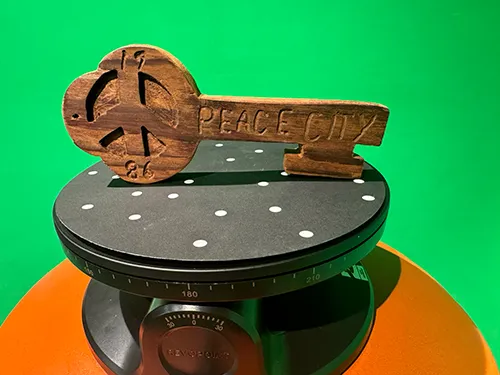
“This key is from a peace march. It was called the Great Peace Walk [for Global Nuclear Disarmament],” says Melbourne. “As folks walked in protest across the country, they would go from city to city and a mayor would be like, ‘Here, here's a key to the city.’ We have a whole box of them.”
“We wanted to recreate an object in a way that would preserve a lot of its materiality for the visually impaired,” says Licastro. “Opeyemi and Ahmad scanned this using our 3D scanner. And then we went to the MakerSpace and actually 3D printed it. It really has a lot of the wood grain in it. It has a lot of the same grooves. It’s a pretty good representation of something if you needed it to be handled, especially by the visually impaired who would really need to feel the textures and objects.”
“We can do this with a variety of objects,” says Licastro. “We can also make things lighter. If this was a very heavy object, we could make a lighter version for those who maybe were suffering from arthritis, or ALS, or muscle atrophy.”
Another exciting aspect of the Libraries’ 3D scanning and 3D printing abilities is the power to take artifacts that were no longer usable, and make them usable again.
“This is an engraving block from the early 1900s,” says Melbourne. “It's from Lake Mohonk Peace Conferences. You can see that they clearly made some kind of logo that was used. You would put ink and then transfer it onto paper. But because it's an original object, we would never be able to apply ink to it. So that's why it was exciting to get it scanned and reproduced.”
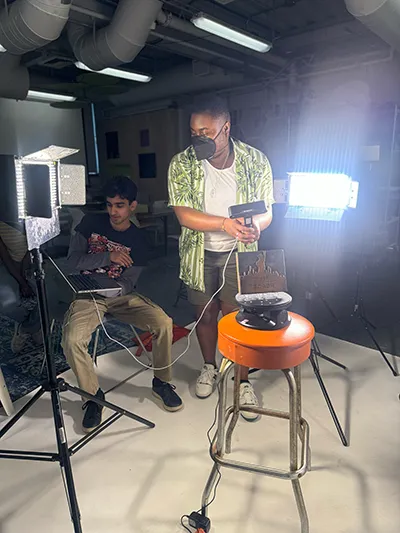
“We ordered linoleum, and we took it to the MakerSpace,” says Licastro. “[In collaboration with the MakerSpace Manager Joshua Jordan,] we created an inverse image that we could put in the laser cutter and we laser cut the linoleum to be an exact match. We also 3D printed it, which is great for applying ink and pressing it with your hands onto something. Then we found reclaimed maple from the campus that is the same maple as the original, and recreated [the block] with the linoleum top on maple.”
“For Garnet Day on November 1, we partnered with [the Get Out the Vote Committee], and we had ‘make your own bag pop-up printing’ with these,” Licastro added. “So you could ink it up and press it down and we had a variety of colors and you could put it anywhere on the bag.”
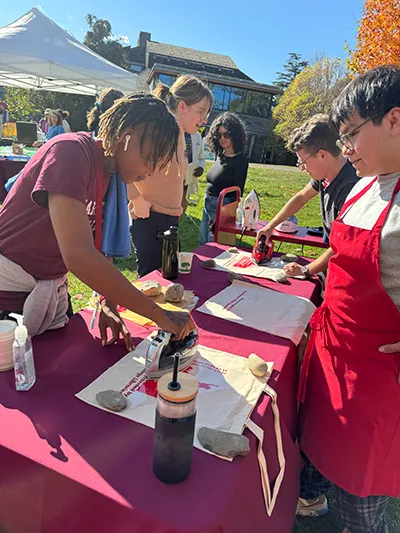
“And that all came from just me taking a 2D scan of the top of the engraved block, and then we went into Photoshop and turned it into a vector,” says Ogundele. “Being able to take a picture and then have it turned into that is so cool.”
“Overall, it was very fun,” Ogundele adds. “I had never done anything like it before, and I was so honored that Amanda felt that my expertise and experience in digital accessibility was so valuable. I was learning how to use a lot of new technology. Me and Ahmad, we made a very good team.”
“I think Amanda and Emily [Higgs Kopin, head of digital collections strategy] were just very understanding, very patient, and it really did feel like we were all in it together,” says Ogundele. “Any time there was a major breakthrough, we were just jumping up and down.”
